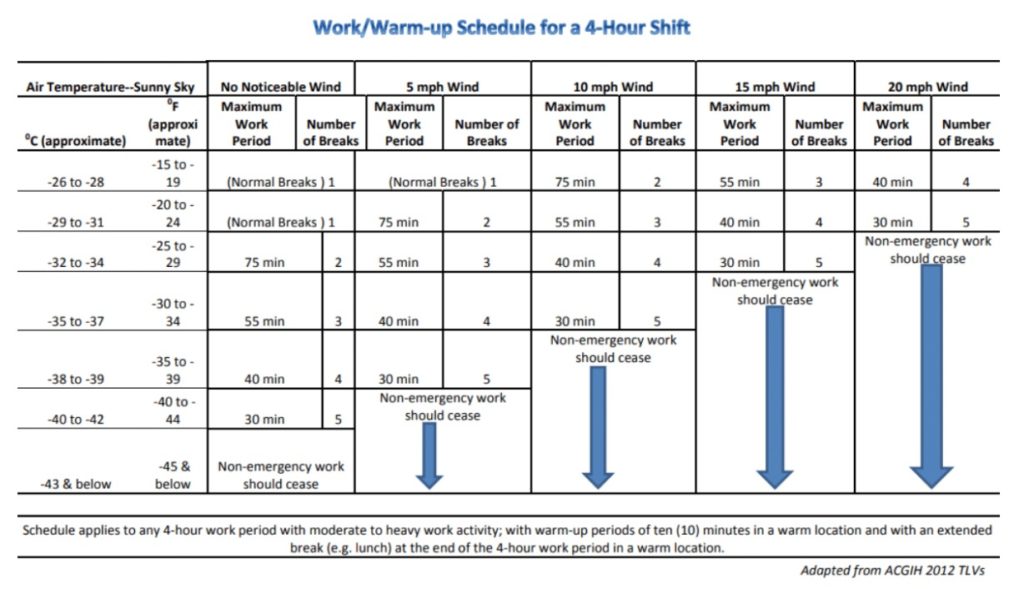With November comes the transition from fall to winter—which means the return of cold temperatures and cold weather injuries. Cold stress can affect any worker exposed to cold air temperatures.
As safety leaders, our job is to ensure that workers have employment and a place of work free from recognized hazards, including cold stress.
What Is Cold Stress?
Cold stress is the leading cause of several cold weather injuries. The condition occurs when a person’s body temperature fails to maintain an average temperature (i.e., 98.6° F).
As a result, the body must work harder to support its core temperature, which then causes additional stress on an individual.
Four critical factors contribute to cold stress:
- Cold temperatures
- Windchill
- Dampness
- Cold water
The condition may also result from poor fitness and health, ineffective PPE, exhaustion, and other underlying health conditions.
Types of Cold Weather Injuries
When an employee experiences cold stress symptoms, they may develop the following injuries:
Trench foot
Trench foot occurs when a person’s feet are wet for an extended period. The condition can be painful, ultimately causing skin and tissue to break down while increasing the risk of infection.
Symptoms: A person may experience numbness, blotchy skin, pain, swelling or a heavy feeling in the foot area.
What to do next: Wet socks and shoes should be removed or replaced with dry socks and shoes. The individual should also obtain medical assistance as soon as possible.
Frostbite
Frostbite is an injury that develops from freezing temperatures that affect the skin and underlying tissues. Frostbite may occur after a person encounters ice, freezing metals or icy liquids.
This type of injury can cause permanent damage to the body and, in severe cases, lead to amputation. Unlike trench foot, frostbite can affect any body part, but the extremities, such as hands, feet, ears, nose and lips, are the most common.
Symptoms: Frostbite can be painful, starting with the sensation of pins and needles before becoming numb as the tissues freeze.
What to do next: If you or a fellow employee is experiencing these symptoms, you need to move the individual to a warm environment immediately. If symptoms are severe, a physician should examine the area, check vital signs and determine treatment.
Hypothermia
Hypothermia occurs when the body temperature drops to less than 95° F due to prolonged exposure to cold temperatures or immersion in a cold body of water.
When a person’s body temperature is dangerously low, the brain and body cannot function properly. If left untreated, hypothermia can lead to cardiac arrest and death.
Symptoms: Signs of hypothermia include shivering, slurred speech, shallow or slow breathing, weak pulse, lack of coordination, drowsiness, confusion and loss of consciousness.
What to do next: If you suspect someone has hypothermia, call 911 or your local emergency number, then gently move the person out of the cold. The following resource from the Mayo Clinic walks you through how to treat someone with hypothermia.
Wind Chill
High wind speeds coupled with low temperatures can be a deadly hazard. Outdoor workers exposed to cold and windy conditions are particularly at higher risk.
Symptoms: A person may exhibit the following symptoms when exposed to wind chill: uncontrollable shivering, exhaustion, disorientation or memory loss.
What to do next: Move the individual to a warm area and check for signs of frostbite or early signs of hypothermia.
Use the wind chill index to help determine when dangerous conditions could lead to frostbite or hypothermia.
- The National Weather Service (NWS) Wind Chill Calculator helps calculate the dangers of winter winds and freezing temperatures. You can also use this tool to gauge workers’ exposure risk and create a plan on how they can safely accomplish their work.
- The American Conference of Governmental Industrial Hygienists (ACGIH) also offers a tool called the Work/Warm-up Schedule that provides recommendations on scheduling work breaks and ceasing non-emergency work.
See below for detail:

For a thorough overview of cold weather hazards, see DOWNLOAD OSHA RESOURCE.
Cold Stress in the Workplace
Under OSHA’s guidelines, workers need to understand how to recognize cold stress-related issues, including:
- Cold stress symptoms and how to prevent related injuries and illnesses.
- The importance of self-monitoring and monitoring coworkers for symptoms.
- How to administer first aid and call for additional medical assistance in an emergency.
- How to select proper clothing for cold, wet, and windy conditions.
Keep in mind that MNOSHA requires all outdoor sanitation units to be heated beginning November 1st. So if you have an OSHA inspection, you surely don’t want to get cited for something as small as not providing heaters for your portable restrooms!
For more information, see the Minnesota Administrative Rules.
Educate. Empower. Advocate.
At OECS, our mission is to help business leaders understand their OSHA requirements and develop safety procedures to prevent workplace injuries, including cold weather injuries. We believe this begins with educating your team and empowering them to practice safely daily.
Connect with us to learn how we can help you build a culture committed to workplace safety.
We support businesses representing the manufacturing and construction industries and can help you prepare your buildings and employees for the cold months ahead.
To request a free consultation, we invite you to call us at 763-417-9599, email us at info@oecscomply.com, or complete our contact form.
 763.417.9599
763.417.9599
